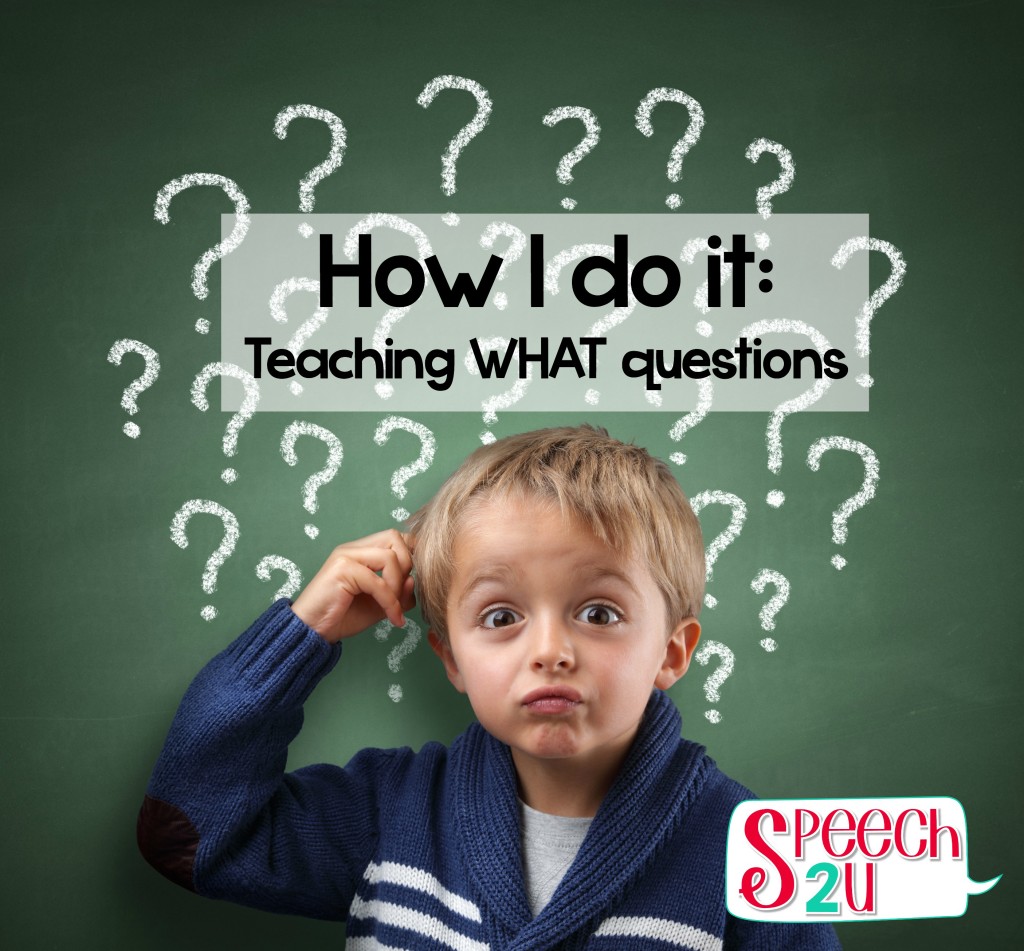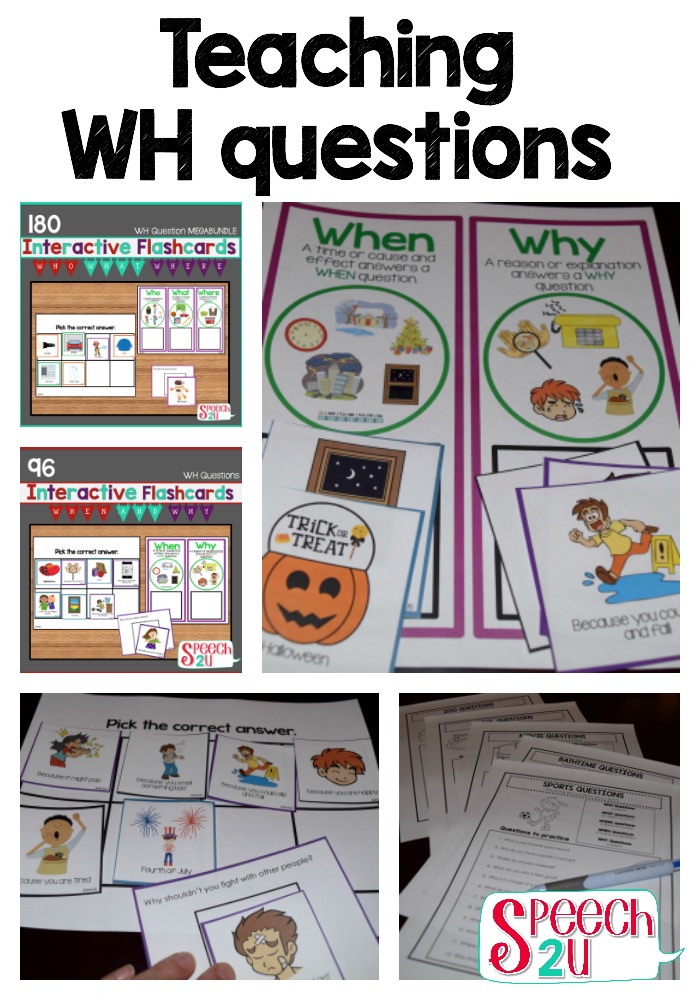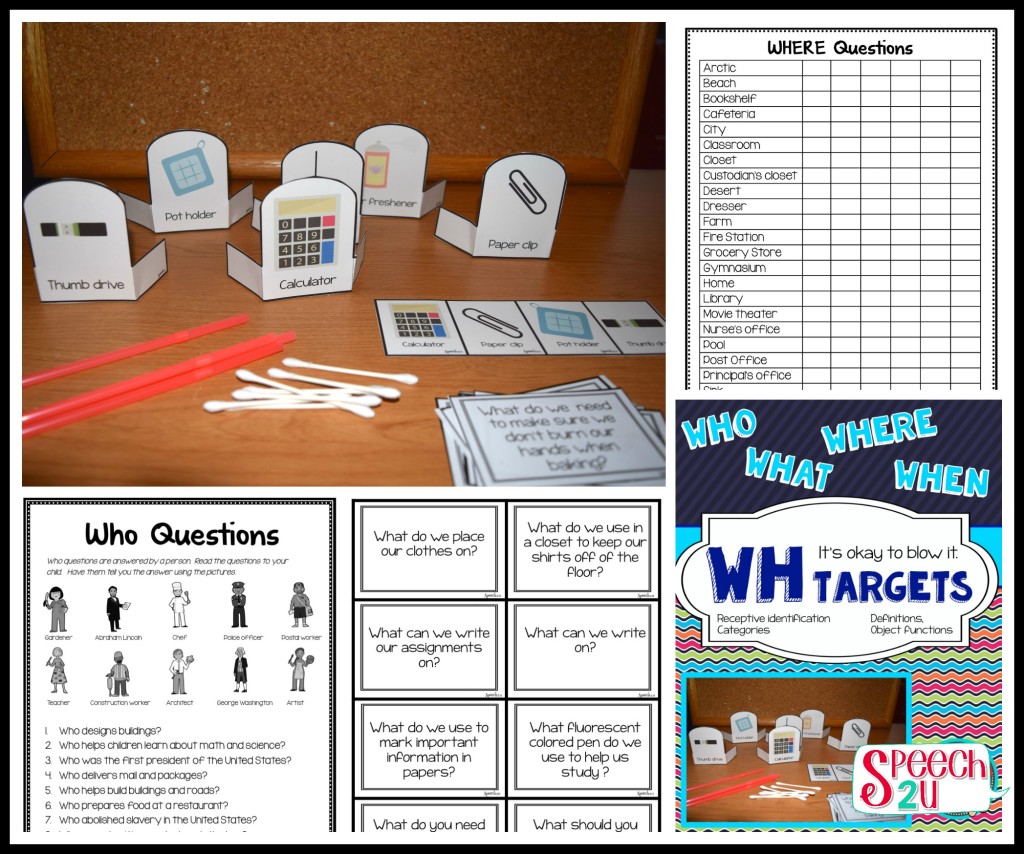WHAT questions are probably some of the easiest questions to teach in speech therapy because the answer is generally a concrete object or an action. A few weeks ago, I wrote a post about why children have difficulty answering different WH questions. I’m following up by talking about how I teach each specific WH question. (This post contains affiliate links. I’ve always linked to products I love to make it easier for readers to find the product. If you love it too, and choose to buy it using my affiliate link, I get a small amount of compensation in return. It’s kind of a win for everyone, right?)

NAMING WHAT QUESTIONS
I usually start by teaching naming WHAT questions as these are the easiest to answer. Naming questions typically require the child to label an object or an associated object. It’s working on both expressive vocabulary and comprehension at the same time. A few naming questions I might use:
- What is it?
- What says? (What says moo?)
- What goes with? (What goes with socks?)
I love, love, love to use real objects in therapy and incorporate my goals into play or activity based exercises. I’ve got some fun ways to work with pictures and card decks, but I find that real objects are more motivating for most of my clients. The iPad also has some flashcard apps out there-but most of them are uninspired. They are basically just pictures with some reinforcement. I’d like to think that I am more fun than the iPad-but there are days where that may not be true. There are exceptions to every rule. Come back on Thursday to see three fun apps to use in therapy for teaching or practicing WHAT questions.
What question activities
- Hiding objects: Who doesn’t love a treasure hunt or finding an object? You can hide small objects in a bin or popcorn or rice, objects in Easter eggs or just hide them around the room to see if your students can find them. As they find the objects, they can tell you what they are. Put a few objects in a feely box and you can start working on some attributes with your comprehension task. (Ex. I feel something that is soft and round. When they pull it out, you ask, “What is it?” Maybe it’s a squishy ball.”) Check out this awesome tutorial on how to make a feely box HERE.
- Packing a suitcase or car for a trip: I have a play suitcase that I use in therapy with my object boxes. We can decide what we will or will not take by pulling the objects out of the bag. (ex. What is it? T-rex. Hmmmm, Do I want to take a T-rex to disneyland? For my clients who LOVE cars/trucks, we will put 10 objects in a bus, dump truck or train and then “drive” it around the room.
- Lift the Flap picture books: Lift the flap books are motivating-and a great way to work on “What is it? questions. One of my Favorites is the DK’s Noisy Peek-a-Boo books. Sometimes when you lift the flap-it makes a noise. The variable reinforcement holds most of my client’s interests.
If you are interested in checking it out-click on the picture below (using my affiliate link):
OBJECT FUNCTION WHAT QUESTIONS
My clients usually pick up What is questions pretty quickly. Once they are starting to master those questions, I add on object function questions. These questions ask the child to tell or explain what they DO with an object. Some examples of questions I’ve used:
- What does it do? (What do scissors do?)
- What can you do with ______? (What can you do with scissors?)
- What (VERBS)? (What cuts?)
- What do you need to ______? (What do you need to make a pizza?)
Object Function Activities
- Craft/cooking activities: It’s fun to work on object function questions within a craft or cooking activity. I like to pretend to be incompetent and ask, “I need to stir. What could I use to stir with?” Children are able to use cues within the environment and give me the object requested.
- Object Function box: This is one of my favorite things to use in therapy. You can purchase an object function box but I collected small toys and objects over the years. Children seem to be drawn to miniature OR extra large objects. I use these in a variety of activities, You can have kids use tongs to pick up one, state the object function and then walk across the room and drop it in the bucket.
Once the student has learned basic WHAT questions, you can start to work on personal preference activities, identifying actions and predicting questions.
Interested in learning more about teaching questions? You may like my WH question Interactive flashcard bundles.
If you just want a motivating activity for targeting WHAT questions, check out my WH question darts. Things are definitely more fun when you are knocking things over.
QUESTION: What’s the most challenging question form to teach? Do you have a special strategy for teaching it? I’d love to read about it in the comments below.
If you think this post was helpful, I would be super excited if you would share this post on Facebook or Twitter.





I do not use this viewpoint although our overall targets match. To me the question is the stimulus and the targeted behavior/language is the response. If my targeted response is verbal labeling, or verbal expression of function, category or description, that is the wording I use in my objective/goal. Labeling people by gender and/or occupation is the response to who questions. Identifying actions verbally is the response to a what question-…but what doing. Using prepositions is the response to where questions. I find this approach steers my student clinicians to more accurate data and developmental level. By being specific about the expected/targeted response, I write a specific measurable goal. I love your variety of creative procedures to obtain target responses.
Great points! I usually write more general goals as well-but when I am teaching, I break things down into categories.
I am LOVING your WH Interactive Flashcards. Out of What, Where, & Who, where is tough to teach, because the student often wants to say “right there” instead of using their words.
Those “darts” look like such fun!!
Thanks for stopping by! I have a lot of clients who struggle with saying “right there” instead of being specifics.